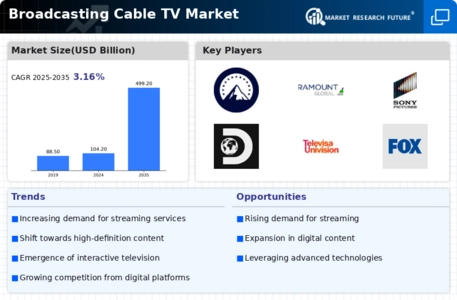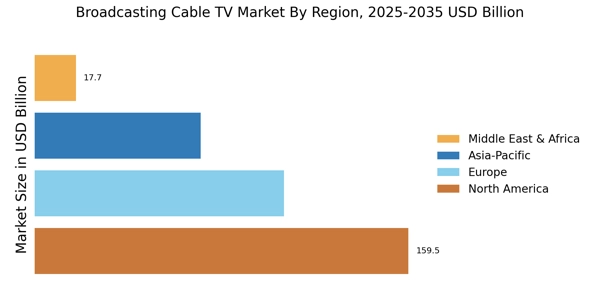Shift Towards Bundled Services
The Broadcasting Cable TV Market is experiencing a shift towards bundled service offerings. Consumers are increasingly seeking value through packages that combine cable television, internet, and phone services. As of 2025, approximately 45% of cable subscribers opt for bundled services, reflecting a growing trend towards convenience and cost-effectiveness. This shift compels cable providers to innovate their service offerings, ensuring that they remain competitive in a saturated market. By providing comprehensive packages, companies can enhance customer retention and satisfaction, thereby positively impacting the overall dynamics of the Broadcasting Cable TV Market.
Regulatory Changes and Compliance
Regulatory frameworks play a crucial role in shaping the Broadcasting Cable TV Market. Recent changes in regulations regarding content distribution and net neutrality have significant implications for cable operators. For instance, the introduction of policies that promote fair competition may lead to increased investment in content creation and distribution. As of 2025, it is estimated that compliance with these regulations could cost cable operators up to 10% of their annual revenue. This financial impact compels companies to innovate and adapt their business models, ultimately influencing the dynamics of the Broadcasting Cable TV Market.
Rising Demand for Live Sports and Events
The Broadcasting Cable TV Market is witnessing a surge in demand for live sports and events programming. As of 2025, live sports account for nearly 30% of all cable viewership, indicating a strong consumer preference for real-time content. This trend is further fueled by the increasing popularity of sports leagues and events, which attract substantial advertising revenue. Cable providers are responding by securing exclusive broadcasting rights, thereby enhancing their value proposition to subscribers. This focus on live content not only drives subscriber growth but also reinforces the competitive landscape within the Broadcasting Cable TV Market.
Technological Advancements in Broadcasting
The Broadcasting Cable TV Market is experiencing a notable transformation due to rapid technological advancements. Innovations such as 4K and 8K resolution broadcasting, along with enhanced compression technologies, are elevating the viewing experience. As of 2025, approximately 60% of households are equipped with 4K televisions, which drives demand for high-definition content. Furthermore, the integration of artificial intelligence in content recommendation systems is reshaping how viewers engage with programming. This technological evolution not only enhances viewer satisfaction but also encourages cable providers to invest in infrastructure upgrades, thereby fostering competition within the Broadcasting Cable TV Market.
Increased Competition from Alternative Platforms
The Broadcasting Cable TV Market faces intensified competition from alternative platforms such as streaming services and digital content providers. As of 2025, it is estimated that over 50% of households subscribe to at least one streaming service, which poses a challenge for traditional cable operators. This competitive pressure encourages cable companies to diversify their content offerings and adopt hybrid models that incorporate both traditional broadcasting and streaming capabilities. By doing so, they can appeal to a broader audience and mitigate the risk of subscriber churn, ultimately influencing the trajectory of the Broadcasting Cable TV Market.



















Leave a Comment